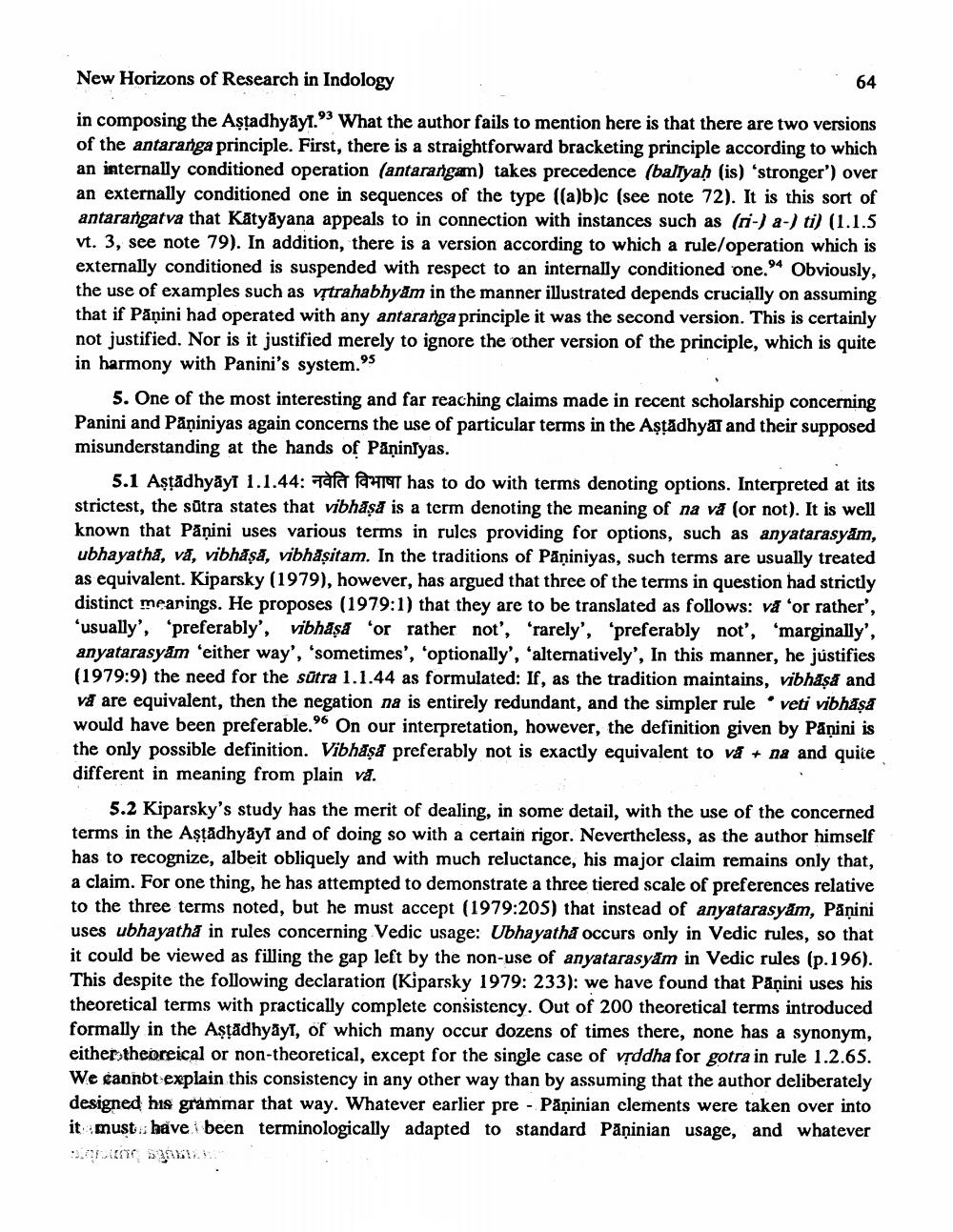________________
New Horizons of Research in Indology
in composing the Aṣṭadhyayt." What the author fails to mention here is that there are two versions of the antaranga principle. First, there is a straightforward bracketing principle according to which an internally conditioned operation (antarangam) takes precedence (ballyah (is) 'stronger') over an externally conditioned one in sequences of the type ((a)b)c (see note 72). It is this sort of antarangatva that Katyayana appeals to in connection with instances such as (ri-) a-) ti) (1.1.5 vt. 3, see note 79). In addition, there is a version according to which a rule/operation which is externally conditioned is suspended with respect to an internally conditioned one." Obviously, the use of examples such as vṛtrahabhyam in the manner illustrated depends crucially on assuming that if Panini had operated with any antaranga principle it was the second version. This is certainly not justified. Nor is it justified merely to ignore the other version of the principle, which is quite in harmony with Panini's system.95
64
5. One of the most interesting and far reaching claims made in recent scholarship concerning Panini and Paniniyas again concerns the use of particular terms in the Aṣṭādhya and their supposed misunderstanding at the hands of Paninlyas.
5.1 Aştadhyay 1.1.44: fer far has to do with terms denoting options. Interpreted at its strictest, the sutra states that vibhāṣa is a term denoting the meaning of na va (or not). It is well known that Panini uses various terms in rules providing for options, such as anyatarasyam, ubhayatha, va, vibhāṣa, vibhāṣitam. In the traditions of Paniniyas, such terms are usually treated as equivalent. Kiparsky (1979), however, has argued that three of the terms in question had strictly distinct meanings. He proposes (1979:1) that they are to be translated as follows: v 'or rather', 'usually', 'preferably', vibhasa 'or rather not', 'rarely', 'preferably not', 'marginally', anyatarasyam 'either way', 'sometimes', 'optionally', 'alternatively', In this manner, he justifies (1979:9) the need for the sutra 1.1.44 as formulated: If, as the tradition maintains, vibhāṣā and va are equivalent, then the negation na is entirely redundant, and the simpler rule veti vibhāṣā would have been preferable." On our interpretation, however, the definition given by Panini is the only possible definition. Vibhasa preferably not is exactly equivalent to va+ na and quite different in meaning from plain va
5.2 Kiparsky's study has the merit of dealing, in some detail, with the use of the concerned terms in the Astädhyayt and of doing so with a certain rigor. Nevertheless, as the author himself has to recognize, albeit obliquely and with much reluctance, his major claim remains only that, a claim. For one thing, he has attempted to demonstrate a three tiered scale of preferences relative to the three terms noted, but he must accept (1979:205) that instead of anyatarasyam, Panini uses ubhayatha in rules concerning Vedic usage: Ubhayath occurs only in Vedic rules, so that it could be viewed as filling the gap left by the non-use of anyatarasyam in Vedic rules (p.196). This despite the following declaration (Kiparsky 1979: 233): we have found that Panini uses his theoretical terms with practically complete consistency. Out of 200 theoretical terms introduced formally in the Astädhyay, of which many occur dozens of times there, none has a synonym, either theorcical or non-theoretical, except for the single case of vṛddha for gotra in rule 1.2.65. We cannot explain this consistency in any other way than by assuming that the author deliberately designed his grammar that way. Whatever earlier pre - Paninian clements were taken over into it must have been terminologically adapted to standard Paninian usage, and whatever
iqring som




